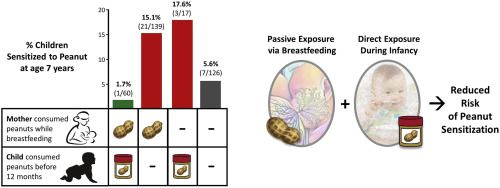Journal of Allergy and Clinical Immunology ( IF 11.4 ) Pub Date : 2017-09-12 , DOI: 10.1016/j.jaci.2017.06.024 Tracy J. Pitt , Allan B. Becker , Moira Chan-Yeung , Edmond S. Chan , Wade T.A. Watson , Rishma Chooniedass , Meghan B. Azad

|
Background
Recent trials have shown that avoiding peanuts during infancy increases the risk of peanut allergy; however, these studies did not address maternal peanut consumption.
Objective
We sought to investigate the relationship between maternal peanut consumption while breast-feeding, timing of direct peanut introduction, and peanut sensitization at age 7 years.
Methods
Secondary analysis of a nested cohort within the 1995 Canadian Asthma Primary Prevention Study intervention study was performed. Breast-feeding and maternal and infant peanut consumption were captured by repeated questionnaires during infancy. Skin prick testing for peanut sensitization was performed at age 7 years.
Results
Overall, 58.2% of mothers consumed peanuts while breast-feeding and 22.5% directly introduced peanuts to their infant by 12 months. At 7 years, 9.4% of children were sensitized to peanuts. The lowest incidence (1.7%) was observed among children whose mothers consumed peanuts while breast-feeding and directly introduced peanuts before 12 months. Incidence was significantly higher (P < .05) if mothers consumed peanuts while breast-feeding but delayed introducing peanuts to their infant beyond 12 months (15.1%), or if mothers avoided peanuts themselves but directly introduced peanuts by 12 months (17.6%). Interaction analyses controlling for study group and maternal atopy confirmed that maternal peanut consumption while breast-feeding and infant peanut consumption by 12 months were protective in combination, whereas either exposure in isolation was associated with an increased risk of sensitization (P interaction = .003).
Conclusions
In this secondary analysis, maternal peanut consumption while breast-feeding paired with direct introduction of peanuts in the first year of life was associated with the lowest risk of peanut sensitization, compared with all other combinations of maternal and infant peanut consumption.
中文翻译:

通过母乳喂养和早期引入花生降低花生过敏的风险
背景
最近的试验表明,在婴儿期避免食用花生会增加花生过敏的风险。但是,这些研究并未解决孕妇食用花生的问题。
客观的
我们试图调查母乳喂养时母体食用花生,直接引入花生的时间和7岁时花生过敏的关系。
方法
在1995年加拿大哮喘一级预防研究干预研究中对嵌套队列进行了二级分析。在婴儿期通过重复调查表获取母乳喂养和母婴花生摄入量。在7岁时进行了针对花生致敏性的皮肤点刺测试。
结果
总体而言,在母乳喂养期间,有58.2%的母亲食用花生,到12个月时,有22.5%的母亲将花生直接引入了婴儿。7岁时,有9.4%的儿童对花生过敏。在母亲在哺乳期间食用花生并在12个月前直接引入花生的儿童中,发生率最低(1.7%)。发生率明显更高(P <.05)如果母亲在母乳喂养时食用了花生,但将花生推迟引入婴儿的时间超过了12个月(15.1%),或者母亲避免自己食用花生但直接在12个月内引入了花生(17.6%)。控制研究组和母源性特应性的相互作用分析证实,母乳喂养时母体食用花生与12个月婴儿花生食用相结合具有保护性,而单独接触二者均与致敏风险增加相关(P交互作用= 0.003)。 。
结论
在该次要分析中,与母婴食用的所有其他组合相比,母乳喂养时母乳喂养的摄入量加上出生后第一年直接引入花生与花生致敏风险最低。











































 京公网安备 11010802027423号
京公网安备 11010802027423号